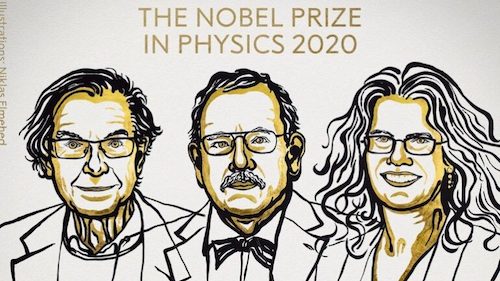
Professor Andrea Ghez wins the 2020 Nobel Prize in Physics!!!
Andrea Ghez, the Director of the UCLA Galactic Center Group, wins 2020 Nobel Prize in physics, for her pioneering research on the Milky Way's supermassive black hole. Read more.
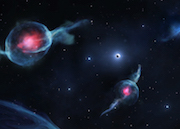
Discovering a new class of strange objects near our Galaxy's enormous back hole
A study lead by a GCG postdoc, Anna Ciurlo, reported a discovery of a new class of bizarre objects at the center of our galaxy, not far from the supermassive black hole called Sagittarius A*. They published their research in the Jan. 16 issue of the journal Nature. “These objects look like gas and behave like stars,” said co-author Andrea Ghez, UCLA’s Lauren B. Leichtman and Arthur E. Levine Professor of Astrophysics and director of the UCLA Galactic Center Group. Read more.
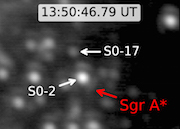
The galactic supermassive black hole became extremely bright in May!
The Galactic Center Group lead by Dr. Tuan Do observed an extremely bright and unexpected flare from the supermassive black hole at the center of the Milky Way Galaxy. Read more
Also check out the video in which GCG members Tuan, Abhimat and Kelly talk about frequently-asked questions about Sgr A*.
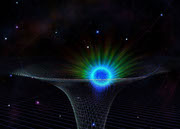
Detection of the general relativity effects around a supermassive black hole
According to Einstein’s 1915 theory of general relativity, what we perceive as the force of gravity arises from the curvature of space and time. The scientist proposed that objects such as the sun and the Earth change this geometry. Einstein’s theory is the best description of how gravity works. Now, in the most comprehensive test of general relativity near the monstrous black hole at the center of our galaxy, the Galactic Center group (GCG) reports that Einstein’s theory of general relativity holds up. The paper announcing the results has been published in Science and it has been covered in various articles including: National Geographic, Smithsonian, CNN, and Sky and Telescope. Read more.

Professor Ghez receives honorary degree from Oxford
Professor Andrea, Ghez, the GCC Director, was awarded an honorary degree from Oxford University during its annual Encaenia ceremony. Ghez demonstrated the existence of a supermassive black hole at the center of our galaxy, with a mass 4 million times that of our sun. Her work provided the best evidence yet that these exotic objects really do exist, providing an opportunity to study the fundamental laws of physics in the extreme environment near a black hole, and learn what role this black hole has played in the formation and evolution of our galaxy. Read more.

More mystery objects detected near Milky Way's supermassive black hole
Near the supermassive black hole at the Milky Way's center, astronomers have discovered strange, puffy objects that look like gas clouds but act like stars. A team led by the Galactic Center Group's postdoctoral scholar, Anna Ciurlo, made the discovery using 12 years of data from the W. M. Keck Observatory on Mauna Kea in Hawaii. The team discovered these objects by measuring the wavelengths of light released by the structures of gas and dust at the galaxy's center using the Keck Observatory's OH-Suppressing Infrared Imaging Spectrograph. The researchers presented their findings at the American Astronomical Society meeting in Denver on June 7. Based on characteristics such as the objects' movement, the researchers think the objects are dusty stellar objects called G-objects. Read more. Read more.

Getting ready for Einstein Test: S0-2 star is single!
A Galactic Center Group graduate student, Devin Chu, lead the study that has been recently published in The Astrophysical Journal. The paper reports that S0-2 has no significant companion that might affect the measurement of gravitational redshift as S0-2 reaches its closest approach to the supermassive black hole later this year. The study was based on the data obtained using W.M. Keck Observatory's OH-Suppressing Infrared Imaging Spectrograph (OSIRIS) and Laser Guide Star Adaptive Optics. Read more. Read more.
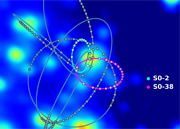
Stars orbiting the supermassive black hole in our Galactic Center provide a test of Einstein’s theory of General Relativity
In this paper, we perform a test of General Relativity using short-period stars like S0-2, which orbits the black hole at the center of our Galaxy with a period of 16 years and which will reach speeds of several percent of the speed of light at its point of closest approach in 2018. This analysis, the first one of this kind, opens a new window to study gravitation using orbital dynamics in a strong gravitational field around a supermassive black hole. Testing General Relativity is important to search for a quantum theory of gravity and for a theory that would unify all fundamental interactions and to improve our understanding of dark matter and dark energy. In this Letter, we constrain the presence of a fifth force which appears in several modified theories of gravitation by using 20 years of observations at the Keck observatory. As the orbital determinations presented here are refined with continued observations in the near future, the constraints on gravitational theory and stellar dynamics in the Galactic center are expected to undergo substantial improvements.

Professor Ghez Receives the Sven Berggren Prize for 2017
Professor Andrea Ghez, who holds the Lauren B. Leichtman and Arthur E. Levine Chair in Astrophysics and directs the UCLA Galactic Center Group, has been selected to receive the Sven Berggren Prize of 2017 from Sweden’s Royal Physiographic Society in Lund. Ghez will give the Sven Berggren lecture in the city of Lund. The prize commemorates Sven Berggren, a young medical scientist. The prize has been awarded to outstanding researchers, including four Nobel laureates, in the natural sciences, medicine and technology. Read more.
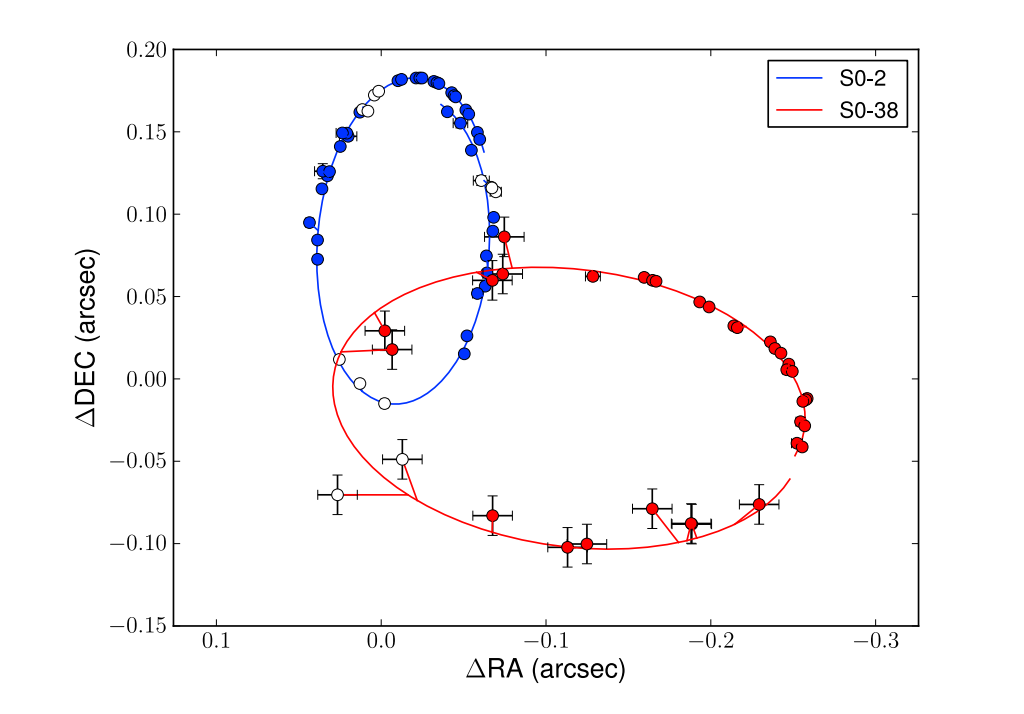
Constraining the Black Hole Parameters using S0-2 and S0-38
Our work on characterizing the Milky Way black hole using multiple stars, which was spearheaded by Anna Boehle, UCLA graduate student, was published recently. Using a more sophisticated speckle reconstruction technique called speckle holography, we were able to extract the positional information from the speckle data from 1995-2013 for the star S0-38. Combining this data with those of S0-2, the improved constraints for the mass and distance of the black hole were estimated. The paper can be found here.

Jerry Magnin Appointed as the Vice Chairman of the Galactic Center Board of Advisors
The UCLA Galactic Center Group Board of Advisors has appointed board member Jerry A. Magnin as vice chairman.
In his new role, Magnin will contribute his considerable corporate and fundraising expertise to garner major philanthropic support for one of the most highly respected infrared astronomy research groups in the world. Read more.

*New* Aspen Winter Conference Feb. 7-12, 2016
The time is now ripe to collect the broader community of experts on galactic nuclei generally and the Galactic Center specifically to share and build upon this recent progress in our understanding of the role played by and dynamical processes near Massive Black Holes.
Important dates are: September 15 2015: Online application opens; November 15 2016: Application deadline

Andrea Ghez to receive Royal Society's Bakerian Medal
Professor Andrea Ghez will be awarded the 2015 Bakerian Medal, the Royal Society’s premiere prize lecture in the physical sciences, the organization announced today. “I’m thrilled to receive the Bakerian Medal from the Royal Society,” said Ghez, who is UCLA’s Lauren B. Leichtman and Arthur E. Levine Professor of Astrophysics. “The research that is being recognized is the product of a wonderful collaboration among the scientists in the UCLA Galactic Center Group and the University of California’s tremendous investment in the W.M. Keck Observatory. Having cutting-edge tools and a great team makes discovery easy.” Read more at Keck Observatory Cosmic Matters.

Smadar Naoz awarded astronomy’s Annie Jump Cannon Prize for outstanding research
Smadar Naoz, assistant professor in the department of physics and astronomy, was selected to receive the prestigious 2015 American Astronomical Society Annie Jump Cannon Prize for outstanding research and the promise for future exceptional research. Her research has explained the surprising observations of many hot Jupiters with orbits that are eccentric or inclined relative to the equator of their host star. Naoz provided the first complete and accurate treatment of the dynamics of such a system, the citation noted. Read more at UCLA News Release Page.
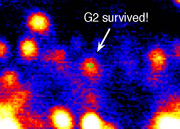
G2 - Bizarre object in our Galactic Center Explained (2014-11-07)
For years, astronomers have been puzzled by G2, a bizarre object in the center of the Milky Way that was believed to be a hydrogen gas cloud headed toward our galxy's enormous black hole. The Galactic Center Group members have determined that G2 is most likely a pair of binary stars that had been orbiting the black hole in tandem and merged together into an extremely large star, embedded in gas and dust, its movements choreographed by the black hole's powerful gravitational field. Read more at UCLA News Release Page.
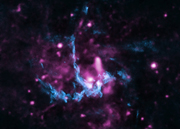
Evidence of Jet in Milky Way's Black Hole (2013-11-20)
Former UCLA assistant researcher Zhiyuan Li and Professor Mark Morris led a team which found evidence for a parsec-scale jet from the galactic center black hole with NASA's Chandra X-ray Observatory and the National Science Foundation's Very Large Array (VLA) radio telescope. This composite image features both X-rays from Chandra (purple) and radio data from the VLA (blue). A labeled version of this image reveals the position of Sagittarius A* (Sgr A* for short) and the suspected jet. Read more at the Chandra page.

Mission to Build the Thirty Meter Telescope (2013-08-01)
A major milestone has been reached for building the Thirty Meter Telescope (TMT).
The UC President and several international partners have signed the agreement. UCLA astronomers will play a significant role in the development and use of the TMT, which will be located in Hawaii and slated ot start in 2022 for the scientific operations. Read more at UCLA News Release Page.
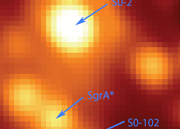
Discovery of the Star with the Shortest Known Orbit around Our Black Hole (2012-10-04)
The Galactic Center Group discovered a star orbiting the supermassive back hole in the center of the Milky Way galaxy with the shortest known orbital period of 11.5 years! Such stars, with their complete orbits observed, can not only provide a means for determining black hole mass but also be used to test general relativity. Read more at UCLA News Release Page.